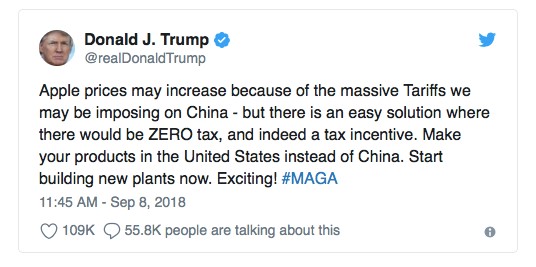Trump has once again called on Apple to bring its manufacturing home to the United States, prompting a dive in Asian suppliers’ shares on Monday with analysts’ warnings that such a move could add 20 percent to iPhone prices.
On Saturday, Trump suggested that the “solution” to a potential increase in Apple product prices due to his tariff war would be to come home.

(Click to enlarge)
The elephant in that Twitter room was the ALL CAPS “ZERO” and the suggestion that a tax incentive could be in play.
Apple’s nervous about the next round of tariffs Trump has threatened on Chinese goods to the tune of—most recently—$267 billion worth, as of Friday. That would include mobile phones.
It’s a threat that Apple says could lead to a 25-percent tax on a line-up of its products, including the Apple Pencil, AirPods, Apple Watch, HomePod, Mac Mini and more, or the components used to make them.
Of course, the customer will pay.
In a September 5th letter submitted by Apple to the United States Trade Representative, the company noted: “Our concern with these tariffs is that the U.S. will be hardest hit, and that will result in lower U.S. growth and competitiveness and higher prices for U.S. consumers.” Related: Are SEC Cannabis Concerns Overblown?
Apple explained the problem at length:
“First, given the balance of Apple’s economic footprint, the burden of the proposed tariffs will fall much more heavily on the United States than on China. The traditional method of calculating the U.S. trade balance attributes the entire value of our products to the country where final assembly is located, in most cases China. That calculation, however, does not reflect the immense value that Apple generates in, and returns to, the United States. Every Apple product contains parts or materials from the United States and is made with equipment from U.S.-based suppliers. …
And every one of these products reflects the labor of 2 million U.S. workers across all 50 states, including our 80,000 direct employees, the 450,000 employees at our 9,000 U.S. suppliers, and 1.53 million U.S. app developers. We expect our total direct contribution to the U.S. economy over the next five years to exceed $350 billion.”
So Trump’s Twittified solution to simply come home ignores quite a few variables that the president may find inconvenient, prompting Bank of America to warn: “The conclusion was for the iPhone (not currently impacted by Tariffs) moving production (100% of final assembly) to the U.S. would need 20% price increases to offset the incremental labor costs,” as reported by CNBC.
In the meantime, it’s worth looking at what Apple already does in the U.S., though the majority of its products are produced in China. According to the Verge:
• Mac Pros are assembled in the U.S.
• Apple invested $1 billion in 2017 in Corning (the manufacturers of the glass used in iPhone screens)
• The company has committed to building three big plants in the U.S.
• The company has said it would spend hundreds of billions in the coming years to hire more workers and invest in domestic infrastructure.
• Foxconn, a key Apple supplier has just set up headquarters in the U.S.
Related: Is Diamond Demand Crumbling?
But let’s face it, China is cheaper so coming home would be a major blow. And for now, no one’s taking the tax incentive bait seriously, though something would have to offset the labor costs. Many have learned, though, that Trump regularly tweets without a plan.
Bank of America Merrill Lynch seems to think Apple might give in to pressure from Trump in some way—possibly by convincing partners to bring some final iPhone assembly operations to the U.S., CNBC reported.
More specifically, BoA analysts said “we believe Apple could ask Hon Hai and Pegatron to shift a small portion of their iPhone manufacturing to the US in response to President Trump's request."
By Tom Kool for Safehaven.com
More Top Reads From Safehaven.com

















